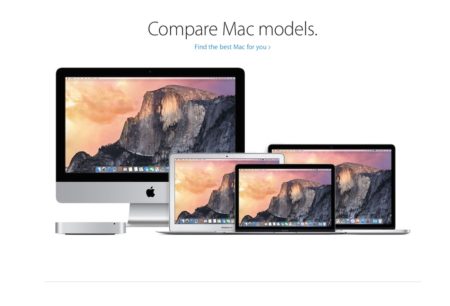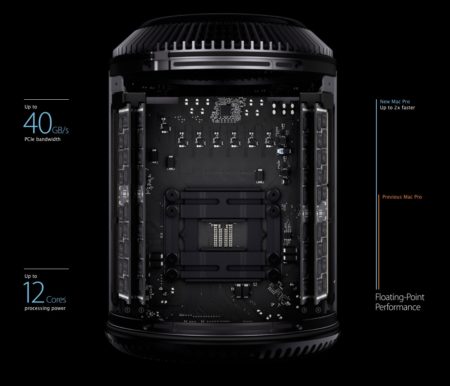Apple just missed the perfect opportunity to update the two year-old new Mac Pro. A machine that still ships. So Mac users need to get used to one obvious fact—something different is coming our way and we hope, and we hope, it returns back to the basics we crave.
The Mac Pro We Hardly Knew
The crowning achievement in hardware disappointment at this year’s WWDC is certainly the lack of an update to the new Mac Pro. Introduced in December 2013, it had been speculated by some that Apple would only update the machine every other CPU update, bypassing architecture tweaks and instead waiting for new manufacturing changes (i.e.: new chip lithography process changes shrink chips into less power-hungry packages). Earlier this year, that is what happened.
MORE: The chip the new Mac Pro may have been waiting for…
With no announcement in Q1 and no hardware at all at this year’s WWDC, it is clear that one of two things is going to happen:
- Apple will quietly exit the professional computer markets such as film and broadcast, architecture and engineering, 3d animation and special effects, photography and graphics, science and medicine, and audio and music production, et cetera, or…
- Apple will re-introduce a new type of professional Mac in a brand new architecture
We are crossing our fingers and praying that Apple doesn’t choose the first option. Why should it? Apple’s Macs have never been as popular and native macOS software for professional markets—like the ones above—have never been this robust. Sure, we can talk about the demise of Apple’s own film industry pro apps, but let’s look beyond that for a moment.

01- Apple’s latest website Mac page refresh has omitted the new Mac Pro but includes the Mac mini. The Mac Pro is Apple’s “pro mac” and it still sells it. But according to some accounts, the Mac Pro accounts for less than 1 percent of all Mac sales.
Apple’s Macs are so popular that they have totally penetrated the mechanical CAD (MCAD) market, a market traditionally dominated by hardcore Wintel blowhards. Autodesk, a company that for well over a decade truly turned its back on the Mac, is now one of Apple’s biggest “big-boy” developer supporters.
And Apple knows very well just how much architects love the Mac. They have even ramped up the presence of the career “type” in numerous keynotes and marketing films, including this WWDC’s own keynote. (see image 03 below)
Why Did The Mac Pro Fail?
We think we know a lot about why the Mac Pro failed. Here at Architosh we have conducted quite a bit of research through surveys. We also talk to all the major CAD and 3D software companies, particularly those serving the building industry.
The Mac Pro didn’t fail, specifically, because it came in another iconic bold simple form, like a cube or sphere or cylinder. It failed not because of shape or sizer, per se, but because it simply did not deliver the things Mac professionals need in the right way. It also failed because it missed on value for one of the biggest pro groups of all—architects.
The Scalable Acquisition of Power
Architects were loyal buyers of the old Mac Pro, and the G4 and G5 Power Macs before that. Why? Because they need power. But they also need a scalable approach to the acquisition of power. The older pro machines did that beautifully. The low-end models provided a reasonable price step up from the top consumer Macs. And yet, they performed better. And they provided pro-level flexibility.

02 – The iconic 2013 Mac Pro is an amazingly beautiful creation, but strategic choices made it impractical for most of the Architecture industry. You would simply get more bang for the buck with a fast iMac than with the “pro” Mac choice. Apple could theoretically fix all this within the design today, but most likely the company will choose another direction.
Contrast that today and the Mac Pro is a big step up in price with zero to negative performance gain for a typical architect. Why? Because all of the major architectural CAD/BIM packages on the market, with the exception of one, will perform at least a bit faster with a high frequency Intel i7 processor than any of the Xeons in the Mac Pro. That’s because the vast majority of CAD and BIM, and even 3D applications, are frequency bound.
The result? Architects have been buying the i7 iMacs in droves instead. iMacs power architecture offices worldwide running everything from the popular SketchUp to Revit to TurboCAD to AutoCAD—you name it. (see: Architosh, “Firm Profile: Candusso Arquitetos—Visualized on the Mac,” 12 April 2012)
Where once architects were firmly the land of Mac Pros, when the latest version came in 2013 those days began to wane.
Putting A Number to Failure
A stat that floated into our ears from reportedly a source in the know, yet we will warn a source we have no track record with, is that today’s Mac Pros account for less than 1 percent of all shipping Macs. In the holiday quarter for 2015, Apple shipped 5.7 million Macs. So 1 percent of 5.7 million Macs is just 57,000 units. And that’s the best quarter and that’s a full 1 percent. It is possible that Apple is selling less than 150,000 Mac Pros a year.
It is important to note that in all of 2002, Apple sold just 3.1 million Macs. Averaged per quarter that is just 750,000 Macs. Divided equally, just for simplicity sake, by its Four Quadrant product strategy—a desktop and mobile variant in pro and consumer lines—that is 187,500 Macs per quarter per category.
But we don’t have to guess quite like that. The company actually reported Power Mac G4 quarterly sales back in 2002 of 212,000 units, with a modest 5 percent growth over the year ago quarter. Now we if roughly multiply that by 4x, Apple sold approximately 848,000 Power Macs in 2002; 27% of all Macs that year were professional desktop machines.
So Apple’s pro desktop branch, in Jobs’ famous Four Quadrant computer strategy, may have withered from being a true quarter of Apple’s computer tree to now just 1 percent or less.¹ Today, with over 100,000 million Mac users worldwide, it is a true shame that Apple has failed to move its users uphill into pro-level hardware, particularly when so many Mac users today are indeed actually professionals in demanding fields.
Fields of Dreams Abound
One of Apple’s most obvious professional fields with a high percentage of Mac users is Architecture. In a research study Architosh undertook a decade ago, architects replace their primary desktop computer on average every 3.1 years. There are, by some estimation, over 1.2 million licensed or chartered architects worldwide, with an estimation of between 3.6 and 5.2 million people working in the field in total.² This would include CAD technicians, visualization and modeling specialists, and other architectural roles, and including all intern-level architects not yet licensed or registered.

03 – Here is an architect. Apple loves showing architects in their marketing materials. And for good reason. Architects do in fact love the Mac and all the other devices too. But Apple has been letting the architecture industry down for a long time on the pro desktop side of things. While the iMac makes sense for a good percentage, an equal or greater percentage would opt in for a more powerful machine they can use for a longer period of time. The iMac is also a poor choice—and increasingly so—for rendering and animation workflows.
Ten years ago, in many European countries Apple’s Mac share of the Architecture market in those countries exceeded 30 percent. Today those markets are even higher and rising. Apple’s potential, in just the Architecture industry, worldwide, is likely in the 20 – 30 percent range. It arguably has the favorable chance to sell to at least 20 percent of 3.6 million professionals in just this industry. Since they replace their machines on average every 3.1 years, Apple could be selling new computers to 1/3 of 720,000 architects worldwide, or roughly 240,000 Macs to architects. Undoubtedly, some of these professionals need a mobile machine, but the vast majority of architectural professionals need a powerful desktop computer.
Apple is very likely selling Mac computers of all kinds to approximately 3/4 of a million architectural users worldwide. But if our source is correct, if the Mac Pro is less than 1 percent of all Macs sold, than the vast majority of architects worldwide are using iMac desktops and Mac mobile computers and somehow making do.
The Solution
To conclude, if Apple’s Mac Pro sales are so paltry that they yield just 150,000 to 200,000 per year (less than 1%), this is just one quarter of Power Mac sales in 2002. Put another way, if Mac Pros today actually account for about 4% of all Mac sales, they approximate 2002 sales for Power Macs.
The solution to this poor performance however is rather simple. Apple needs to stop making signature, iconic machines aimed more for the Smithsonian Institute than for actual production uses and start learning their core pro markets and tailor the next pro desktop design to around those needs.
Apple’s marketing materials and keynote slides don’t belie the situation. (see image 03) Yes, architects are truly Apple users. It’s just a huge percentage of us would love to scale our purchases upward to more powerful desktop machines. We need them. And that’s just focusing in on the Architecture market. For the other “pro” Mac markets Apple has traditionally served, the current Mac situation is often worse.
Let’s hope no hardware at WWDC 2016 portends to something really great come this fall.
Footnotes
1 – Apple stopped breaking out sales of its Macs in the oughts though through the years a variance between mobiles and desktops has been communicated.
2 – According to the International Union of Architects, there are 1.2 million licensed, chartered or equivalent architects worldwide, 566,000 just in Europe. But those without full credentials include the recently graduated intern architects, draftsman and CAD technicians, 3D visualization artists working in architecture offices, construction-related and project management professionals who often have slightly different academic backgrounds than those from accredited architecture schools.



Reader Comments
and then you have the option of using autodesk’s cloud based solutions like fusion360 for CAD/CAM – I design locally on my macbook pro 13, Collaborate online live with my team, and render and animate in the autodesk ‘cloud’ using a few hundred thousand cpu’s and just pay for the rendering time used. http://www.autodesk.com/360-cloud and check out all of autodesks new cloud based services..
For the other 95% of my work (filmmaker), I’m waiting for an updated macbook pro 15 so I can render my darn FCPx faster!.. common Apple gimmi a real speed boost already !!!!
and then you have the option of using autodesk’s cloud based solutions like fusion360 for CAD/CAM – I design locally on my macbook pro 13, Collaborate online live with my team, and render and animate in the autodesk ‘cloud’ using a few hundred thousand cpu’s and just pay for the rendering time used. http://www.autodesk.com/360-cloud and check out all of autodesks new cloud based services..
For the other 95% of my work (filmmaker), I’m waiting for an updated macbook pro 15 so I can render my darn FCPx faster!.. common Apple gimmi a real speed boost already !!!!
Thanks for the feedback Tony! You raise a good point and another reason why the Mac Pro may never be updated again. If pro users choose to render in the cloud increasingly more, than this is an augment against users needing lots of processor cores, one of the chief differences between the i7 and Xeons.
On the other hand, the Pro box that people actually want gives pros real flexibility. And flexibility goes a long way in the face of many changes afoot in the market.
Thanks for the feedback Tony! You raise a good point and another reason why the Mac Pro may never be updated again. If pro users choose to render in the cloud increasingly more, than this is an augment against users needing lots of processor cores, one of the chief differences between the i7 and Xeons.
On the other hand, the Pro box that people actually want gives pros real flexibility. And flexibility goes a long way in the face of many changes afoot in the market.
From December 2015 IDC report:
“Despite the substantial shift in spending and usage models from PCs toward tablets and phones in recent years, very few people are giving up on their PC – they are just making it last longer,” said Loren Loverde.
http://www.idc.com/getdoc.jsp?containerId=prUS40704015
This is another reason why a flexible, upgradable Mac Pro is more appealing to Mac Pros. Given the demand to buy many more electronic devices (and stay up on them, particularly phones) it comes as no surprise that folks need their personal computers to last longer. This is an another argument why the Mac Pro has done poorly. Without the clear path to upgradeable GPUs, for example, why would people purchase a machine they can’t see using for five years without an upgrade path?
If Apple created a new Mac Pro that spoke to professional flexibility and upgradeability on key performance items like GPUs and even CPUs, this would attract folks to outlay top dollar to get into a machine they can grow and live with for many years.
From December 2015 IDC report:
“Despite the substantial shift in spending and usage models from PCs toward tablets and phones in recent years, very few people are giving up on their PC – they are just making it last longer,” said Loren Loverde.
http://www.idc.com/getdoc.jsp?containerId=prUS40704015
This is another reason why a flexible, upgradable Mac Pro is more appealing to Mac Pros. Given the demand to buy many more electronic devices (and stay up on them, particularly phones) it comes as no surprise that folks need their personal computers to last longer. This is an another argument why the Mac Pro has done poorly. Without the clear path to upgradeable GPUs, for example, why would people purchase a machine they can’t see using for five years without an upgrade path?
If Apple created a new Mac Pro that spoke to professional flexibility and upgradeability on key performance items like GPUs and even CPUs, this would attract folks to outlay top dollar to get into a machine they can grow and live with for many years.
If Jobs Failed Twice, Why Would Ive & Team Succeed? RIP new Mac Pro | Architosh – New Mac Pro ? https://t.co/9xKcC7fmkF
If Jobs Failed Twice, Why Would Ive & Team Succeed? RIP new Mac Pro | Architosh – New Mac Pro ? https://t.co/9xKcC7fmkF
couple things;
Apple’s revenues from Macintosh computers is much less than from it’s mobile devices.
Apple is consistently ignoring the enterprise. I’ve sought to install Macs in businesses where I work whenever possible. But when a company will not give out roadmaps or advance announcements of products, it is difficult to plan 12-18 months in advance. In fact this whole wink wink secrecy marketing tactic was old 5 years ago.
The last time I recommended iMacs for a certain media company, the decision maker responded that they were toy computers for students.
couple things;
Apple’s revenues from Macintosh computers is much less than from it’s mobile devices.
Apple is consistently ignoring the enterprise. I’ve sought to install Macs in businesses where I work whenever possible. But when a company will not give out roadmaps or advance announcements of products, it is difficult to plan 12-18 months in advance. In fact this whole wink wink secrecy marketing tactic was old 5 years ago.
The last time I recommended iMacs for a certain media company, the decision maker responded that they were toy computers for students.
[…] Architosh, spécialisé comme son nom l’indique dans l’actualité du Mac pour les architectes, dresse également un tableau très sombre de l’avenir du Mac Pro. Le constat est simple : si le Mac Pro […]
Comments are closed.